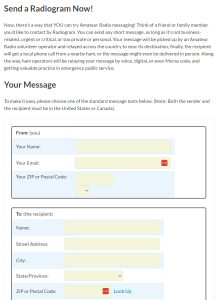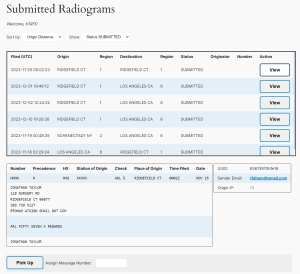The Radiogram Portal
The Radiogram Portal is a Web application which provides a way for members of the general public to submit brief messages to friends or family, which can then be picked up by licensed Amateur Radio operators as formal NTS messages, for transmission and delivery via the existing National Traffic System.
Motivation
There are two motivations for this project: The first is to provide a platform to explain to the general public what Amateur Radio messaging is all about — to give a basic introduction to this part of our public service capability, and then to provide an easy way for someone who’s not a ham to submit a message for origination. The second is to try to inject more true third-party traffic into our traffic system.
The Role of a “Radiogrammer”
A Radiogrammer is a licensed Amateur in the US or Canada who is familiar with formal traffic-handling procedures, and who would like to regularly check in to the Portal to pick up third-party messages for origination.
Design
We refer to the public-facing pages of the Radiogram Portal as the front end, and the password-protected pages used by Radiogrammers as the back end. Both views of the system run on a WordPress instance, currently the NTS 2.0 Web site.
Front End
The screenshot below shows the main, public-facing page of the Portal. It begins with a brief description of Amateur Radio message handling, then encourages the viewer to fill out a message to be sent to a friend or relative, anywhere in the US or Canada. The user provides their own name and e-mail address, the complete contact information for the recipient, and chooses one of the standard ARL Message Texts as the body of the message, followed by an optional closing phrase. If one of the standard texts calls for a fill-in phrase, there’s an opportunity to provide that, too.

Restricting the public to one of the standard message texts is to help ensure that the content of the message will be appropriate for Amateur Radio — not business-related, highly urgent, or exceedingly personal. However, if the end-user happens to be a logged-in, verified Amateur Radio operator, there’s an opportunity to write a free-form message rather than selecting a standard text. The Portal also requires a CAPTCHA to be “solved” before the message is accepted, as a guard against spam.
Upon submitting the message, the user is shown a preview to confirm the address and the content, as well as a glimpse of how the message will actually look when formatted as an NTS Radiogram. A confirmation e-mail is sent to the sender, as well.
At this point, the system converts the message to standard NTS format and stores it in its database. It computes the NTS Region numbers of both the sender and the recipient, as well as the city-of-origin, based on the sender’s postal code.
Back End
Registered, validated Radiogrammers have access to the back end of the system. A Radiogrammer can log in at any time to view messages in the database, with particular attention being paid to those which have been submitted but not yet picked up for NTS origination. An example of the back-end view is shown below.

By default, this list shows messages which have been submitted to the system (typically by non-hams), ready to be picked up for origination as formal traffic. The task of a Radiogrammer is to check this list periodically for messages within their own NTS origin Region, pick them up, and originate them over Amateur Radio in the usual way as formal traffic, using voice, digital, or CW.
A special rule hides Available messages from the list for a certain period of time after being submitted, for any logged-in user who is in a different NTS region than the origin city of the message. This time period defaults to 4 hours, but is adjustable. The aim of this rule is to encourage traffic handlers who are in the same Region as the sender to get first dibs on taking traffic from the Portal, to maximize the geographic effectiveness of NTS.
There are two choices at the top of the page:
Sort by
Origin Distance:
Displays submitted Radiograms in increasing order of distance from your postal code, based on the postal code of the person who submitted the message. This is a useful way to bubble messages from the Radiogrammer’s own NTS Region to the top of the list. To maximize the benefit of Amateur Radio, the goal is to give priority to Radiogrammers who are in the same Region as the city of origin to pick up any such messages.
Time Filed:
Sorts submitted Radiograms in descending order of their filing time, irrespective of location. The most recently submitted messages appear at the top of the list.
Show
Status AVAILABLE:
Displays only those Radiograms which have been submitted to the system, but not yet picked up for origination.
My Originations:
Displays only those Radiograms which the logged-in Radiogrammer has previously picked up for origination. (This view is useful for going back and looking up contact information for the submitter of a message for which the Radiogrammer has received a reply.)
All Messages:
Displays all Radiograms in the system, including those which have already been picked up (or deleted).
Messages List
The Messages List shows all messages which match the selected criteria, along with key data such as the city and region of origin and destination. If a message has already been picked up for origination, the origin station and the message number is also shown. This list is scrollable if the list is long.
To see all details for a message, click the corresponding View button.
Message Actions
After Viewing a message, there are two action buttons below the message which might be displayed, depending on its disposition:
Handle
Click this button to pick up a message for origination by your station. (The Radiogrammer must assign it a message number first.) This marks the message has having been retrieved, and inserts the Radiogrammer’s callsign as the station of origin in the database. The Portal then displays the message in standard Radiogram format, from which one can Copy or Print. At this point, the Radiogrammer would originate the message as formal traffic in the usual way over Amateur Radio, using voice, digital, or CW.
The final step, after originating a message, is to click “Mark as Sent”, which changes the message’s status in the database to Sent.
Delete
Click this button to mark a message as “Deleted”, and to provide a reason for having done so. This is typically used when encountering a message with content that’s inappropriate for Amateur Radio messaging, and therefore can’t be originated. Our current policy is to simply delete any such message, rather than trying to edit it or contact the submitter. (The reason provided is stored only in the database as a notation.)
Reporting
Users with administrative privileges on the WordPress site have access to several reporting pages, which track activity and performance. The following reports are available in real time:
- Roster of active Radiogrammers, showing callsign, postal code, name, and NTS region.
- Overall count of messages in the database (within a date range) for each status (Available, Handling, Sent)
- Count of Sent messages, by origination callsign, within a date range.
- Pick-up time interval (the interval between a message being Submitted and being Handled, or Sent), expressed as minimum, maximum, and mean, broken down by region.
Becoming a “Radiogrammer”
See the Radiogrammer Quick Start Guide for details on how to become a “Radiogrammer”.
